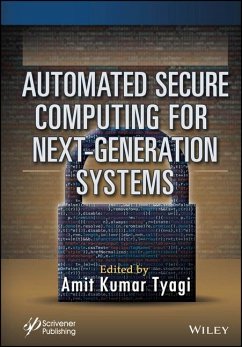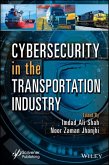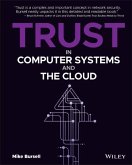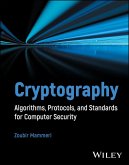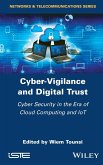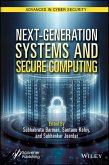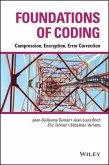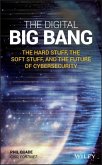Automated Secure Computing for Next-Generation Systems
Herausgeber: Tyagi, Amit Kumar
Automated Secure Computing for Next-Generation Systems
Herausgeber: Tyagi, Amit Kumar
- Gebundenes Buch
- Merkliste
- Auf die Merkliste
- Bewerten Bewerten
- Teilen
- Produkt teilen
- Produkterinnerung
- Produkterinnerung
This book provides cutting-edge chapters on machine-empowered solutions for next-generation systems for today's society. Security is always a primary concern for each application and sector. In the last decade, many techniques and frameworks have been suggested to improve security (data, information, and network). Due to rapid improvements in industry automation, however, systems need to be secured more quickly and efficiently. It is important to explore the best ways to incorporate the suggested solutions to improve their accuracy while reducing their learning cost. During implementation, the…mehr
Andere Kunden interessierten sich auch für
![Cybersecurity in the Transportation Industry Cybersecurity in the Transportation Industry]() Cybersecurity in the Transportation Industry181,99 €
Cybersecurity in the Transportation Industry181,99 €![Trust in Computer Systems and the Cloud Trust in Computer Systems and the Cloud]() Mike BursellTrust in Computer Systems and the Cloud37,99 €
Mike BursellTrust in Computer Systems and the Cloud37,99 €![Cryptography Cryptography]() Zoubir Z MammeriCryptography130,99 €
Zoubir Z MammeriCryptography130,99 €![Cyber-Vigilance and Digital Trust Cyber-Vigilance and Digital Trust]() Cyber-Vigilance and Digital Trust164,99 €
Cyber-Vigilance and Digital Trust164,99 €![Next-Generation Systems and Secure Computing Next-Generation Systems and Secure Computing]() Next-Generation Systems and Secure Computing208,99 €
Next-Generation Systems and Secure Computing208,99 €![Foundations of Coding Foundations of Coding]() Jean-Guillaume DumasFoundations of Coding115,99 €
Jean-Guillaume DumasFoundations of Coding115,99 €![The Digital Big Bang The Digital Big Bang]() Phil QuadeThe Digital Big Bang24,99 €
Phil QuadeThe Digital Big Bang24,99 €-
-
-
This book provides cutting-edge chapters on machine-empowered solutions for next-generation systems for today's society. Security is always a primary concern for each application and sector. In the last decade, many techniques and frameworks have been suggested to improve security (data, information, and network). Due to rapid improvements in industry automation, however, systems need to be secured more quickly and efficiently. It is important to explore the best ways to incorporate the suggested solutions to improve their accuracy while reducing their learning cost. During implementation, the most difficult challenge is determining how to exploit AI and ML algorithms for improved safe service computation while maintaining the user's privacy. The robustness of AI and deep learning, as well as the reliability and privacy of data, is an important part of modern computing. It is essential to determine the security issues of using AI to protect systems or ML-based automated intelligent systems. To enforce them in reality, privacy would have to be maintained throughout the implementation process. This book presents groundbreaking applications related to artificial intelligence and machine learning for more stable and privacy-focused computing. By reflecting on the role of machine learning in information, cyber, and data security, Automated Secure Computing for Next-Generation Systems outlines recent developments in the security domain with artificial intelligence, machine learning, and privacy-preserving methods and strategies. To make computation more secure and confidential, the book provides ways to experiment, conceptualize, and theorize about issues that include AI and machine learning for improved security and preserve privacy in next-generation-based automated and intelligent systems. Hence, this book provides a detailed description of the role of AI, ML, etc., in automated and intelligent systems used for solving critical issues in various sectors of modern society. Audience Researchers in information technology, robotics, security, privacy preservation, and data mining. The book is also suitable for postgraduate and upper-level undergraduate students.
Produktdetails
- Produktdetails
- Verlag: Wiley
- Seitenzahl: 480
- Erscheinungstermin: 19. Dezember 2023
- Englisch
- Gewicht: 1193g
- ISBN-13: 9781394213597
- ISBN-10: 139421359X
- Artikelnr.: 68672151
- Herstellerkennzeichnung
- Libri GmbH
- Europaallee 1
- 36244 Bad Hersfeld
- gpsr@libri.de
- Verlag: Wiley
- Seitenzahl: 480
- Erscheinungstermin: 19. Dezember 2023
- Englisch
- Gewicht: 1193g
- ISBN-13: 9781394213597
- ISBN-10: 139421359X
- Artikelnr.: 68672151
- Herstellerkennzeichnung
- Libri GmbH
- Europaallee 1
- 36244 Bad Hersfeld
- gpsr@libri.de
Amit Kumar Tyagi, PhD, is an assistant professor, at the National Institute of Fashion Technology, New Delhi, India. He has published more than 100 papers in refereed international journals, conferences, and books. He has filed more than 20 national and international patents in the areas of deep learning, Internet of Things, cyber-physical systems, and computer vision. His current research focuses on smart and secure computing and privacy, amongst other interests.
Preface xvii
Acknowledgements xix
Part 1: Fundamentals 1
1 Digital Twin Technology: Necessity of the Future in Education and Beyond
3
Robertas Damasevicius and Ligita Zailskaite-Jakste
1.1 Introduction 3
1.2 Digital Twins in Education 5
1.3 Examples and Case Studies 8
1.4 Discussion 12
1.5 Challenges and Limitations 13
1.6 Conclusion 17
2 An Intersection Between Machine Learning, Security, and Privacy 23
Hareharan P.K., Kanishka J. and Subaasri D.
2.1 Introduction 23
2.2 Machine Learning 24
2.3 Threat Model 27
2.4 Training in a Differential Environment 30
2.5 Inferring in Adversarial Attack 33
2.6 Machine Learning Methods That Are Sustainable, Private, and Accountable
36
2.7 Conclusion 40
3 Decentralized, Distributed Computing for Internet of Things-Based Cloud
Applications 43
Roopa Devi E.M., Shanthakumari R., Rajadevi R., Kayethri D. and Aparna V.
3.1 Introduction to Volunteer Edge Cloud for Internet of Things Utilising
Blockchain 44
3.2 Significance of Volunteer Edge Cloud Concept 45
3.3 Proposed System 46
3.4 Implementation of Volunteer Edge Control 49
3.5 Result Analysis of Volunteer Edge Cloud 52
3.6 Introducing Blockchain-Enabled Internet of Things Systems Using the
Serverless Cloud Platform 53
3.7 Introducing Serverless Cloud Platforms 54
3.8 Serverless Cloud Platform System Design 55
3.9 Evaluation of HCloud 60
3.10 HCloud-Related Works 61
3.11 Conclusion 62
4 Artificial Intelligence-Blockchain-Enabled-Internet of Things-Based Cloud
Applications for Next-Generation Society 65
V. Hemamalini, Anand Kumar Mishra, Amit Kumar Tyagi and Vijayalakshmi
Kakulapati
4.1 Introduction 65
4.2 Background Work 69
4.3 Motivation 71
4.4 Existing Innovations in the Current Society 72
4.5 Expected Innovations in the Next-Generation Society 72
4.6 An Environment with Artificial Intelligence-Blockchain-Enabled-Internet
of Things-Based Cloud Applications 73
4.7 Open Issues in Artificial Intelligence-Blockchain-Enabled-Internet of
Things-Based Cloud Applications 74
4.8 Research Challenges in Artificial
Intelligence-Blockchain-Enabled-Internet of Things-Based Cloud Applications
75
4.9 Legal Challenges in Artificial Intelligence-Blockchain-Enabled-Internet
of Things-Based Cloud Applications 76
4.10 Future Research Opportunities Towards Artificial
Intelligence-Blockchain-Enabled-Internet of Things-Based Cloud Applications
77
4.11 An Open Discussion 78
4.12 Conclusion 79
5 Artificial Intelligence for Cyber Security: Current Trends and Future
Challenges 83
Meghna Manoj Nair, Atharva Deshmukh and Amit Kumar Tyagi
5.1 Introduction: Security and Its Types 83
5.2 Network and Information Security for Industry 4.0 and Society 5.0 86
5.3 Internet Monitoring, Espionage, and Surveillance 89
5.4 Cyber Forensics with Artificial Intelligence and without Artificial
Intelligence 91
5.5 Intrusion Detection and Prevention Systems Using Artificial
Intelligence 92
5.6 Homomorphic Encryption and Cryptographic Obfuscation 94
5.7 Artificial Intelligence Security as Adversarial Machine Learning 95
5.8 Post-Quantum Cryptography 96
5.9 Security and Privacy in Online Social Networks and Other Sectors 98
5.10 Security and Privacy Using Artificial Intelligence in Future
Applications/Smart Applications 99
5.11 Security Management and Security Operations Using Artificial
Intelligence for Society 5.0 and Industry 4.0 101
5.12 Digital Trust and Reputation Using Artificial Intelligence 103
5.13 Human-Centric Cyber Security Solutions 104
5.14 Artificial Intelligence-Based Cyber Security Technologies and
Solutions 106
5.15 Open Issues, Challenges, and New Horizons Towards Artificial
Intelligence and Cyber Security 107
5.16 Future Research with Artificial Intelligence and Cyber Security 109
5.17 Conclusion 110
Part 2: Methods and Techniques 115
6 An Automatic Artificial Intelligence System for Malware Detection 117
Ahmad Moawad, Ahmed Ismail Ebada, A.A. El-Harby and Aya M. Al-Zoghby
6.1 Introduction 117
6.2 Malware Types 119
6.3 Structure Format of Binary Executable Files 121
6.4 Malware Analysis and Detection 124
6.5 Malware Techniques to Evade Analysis and Detection 128
6.6 Malware Detection With Applying AI 130
6.7 Open Issues and Challenges 134
6.8 Discussion and Conclusion 135
7 Early Detection of Darknet Traffic in Internet of Things Applications 139
Ambika N.
7.1 Introduction 139
7.2 Literature Survey 143
7.3 Proposed Work 147
7.4 Analysis of the Work 149
7.5 Future Work 150
7.6 Conclusion 151
8 A Novel and Efficient Approach to Detect Vehicle Insurance Claim Fraud
Using Machine Learning Techniques 155
Anand Kumar Mishra, V. Hemamalini, Amit Kumar Tyagi, Piyali Saha and
Abirami A.
8.1 Introduction 155
8.2 Literature Survey 156
8.3 Implementation and Analysis 157
8.4 Conclusion 174
9 Automated Secure Computing for Fraud Detection in Financial Transactions
177
Kuldeep Singh, Prasanna Kolar, Rebecca Abraham, Vedantam Seetharam,
Sireesha Nanduri and Divyesh Kumar
9.1 Introduction 177
9.2 Historical Perspective 180
9.3 Previous Models for Fraud Detection in Financial Transactions 181
9.4 Proposed Model Based on Automated Secure Computing 182
9.5 Discussion 184
9.6 Conclusion 185
10 Data Anonymization on Biometric Security Using Iris Recognition
Technology 191
Aparna D. K., Malarkodi M., Lakshmanaprakash S., Priya R. L. and Ajay Nair
10.1 Introduction 191
10.2 Problems Faced in Facial Recognition 194
10.3 Face Recognition 197
10.4 The Important Aspects of Facial Recognition 199
10.5 Proposed Methodology 201
10.6 Results and Discussion 202
10.7 Conclusion 202
11 Analysis of Data Anonymization Techniques in Biometric Authentication
System 205
Harini S., Dharshini R., Agalya N., Priya R. L. and Ajay Nair
11.1 Introduction 205
11.2 Literature Survey 207
11.3 Existing Survey 209
11.4 Proposed System 212
11.5 Implementation of AI 219
11.6 Limitations and Future Works 220
11.7 Conclusion 221
Part 3: Applications 223
12 Detection of Bank Fraud Using Machine Learning Techniques 225
Kalyani G., Anand Kumar Mishra, Diya Harish, Amit Kumar Tyagi, Sajidha S.
A. and Shashank Pandey
12.1 Introduction 225
12.2 Literature Review 226
12.3 Problem Description 227
12.4 Implementation and Analysis 228
12.5 Results 238
12.6 Conclusion 238
12.7 Future Works 240
13 An Internet of Things-Integrated Home Automation with Smart Security
System 243
Md. Sayeduzzaman, Touhidul Hasan, Adel A. Nasser and Akashdeep Negi
13.1 Introduction 244
13.2 Literature Review 246
13.3 Methodology and Working Procedure with Diagrams 249
13.4 Research Analysis 252
13.5 Establishment of the Prototype 256
13.6 Results and Discussions 265
13.7 Conclusions 270
14 An Automated Home Security System Using Secure Message Queue Telemetry
Transport Protocol 275
P. Rukmani, S. Graceline Jasmine, M. Vergin Raja Sarobin, L. Jani Anbarasi
and Soumitro Datta
14.1 Introduction 275
14.2 Related Works 277
14.3 Proposed Solution 278
14.4 Implementation 285
14.5 Results 290
14.6 Conclusion and Future Work 292
15 Machine Learning-Based Solutions for Internet of Things-Based
Applications 295
Varsha Bhatia and Bhavesh Bhatia
15.1 Introduction 295
15.2 IoT Ecosystem 296
15.3 Importance of Data in IoT Applications 298
15.4 Machine Learning 299
15.5 Machine Learning Algorithms 302
15.6 Applications of Machine Learning in IoT 304
15.7 Challenges of Implementing ML for IoT Solutions 313
15.8 Emerging Trends in IoT 314
15.9 Conclusion 315
16 Machine Learning-Based Intelligent Power Systems 319
Kusumika Krori Dutta, S. Poornima, R. Subha, Lipika Deka and Archit Kamath
16.1 Introduction 319
16.2 Machine Learning Techniques 321
16.3 Implementation of ML Techniques in Smart Power Systems 334
16.4 Case Study 340
16.5 Conclusion 341
Part 4: Future Research Opportunities 345
17 Quantum Computation, Quantum Information, and Quantum Key Distribution
347
Mohanaprabhu D., Monish Kanna S. P., Jayasuriya J., Lakshmanaprakash S.,
Abirami A. and Amit Kumar Tyagi
17.1 Introduction 347
17.2 Literature Work 352
17.3 Motivation Behind this Study 353
17.4 Existing Players in the Market 354
17.5 Quantum Key Distribution 356
17.6 Proposed Models for Quantum Computing 356
17.7 Simulation/Result 361
17.8 Conclusion 365
18 Quantum Computing, Qubits with Artificial Intelligence, and Blockchain
Technologies: A Roadmap for the Future 367
Amit Kumar Tyagi, Anand Kumar Mishra, Aswathy S. U. and Shabnam Kumari
18.1 Introduction to Quantum Computing and Its Related Terms 368
18.2 How Quantum Computing is Different from Security? 374
18.3 Artificial Intelligence-Blockchain-Based Quantum Computing? 375
18.4 Process to Build a Quantum Computer 378
18.5 Popular Issues with Quantum Computing in this Smart Era 379
18.6 Problems Faced with Artificial Intelligence-Blockchain-Based Quantum
Computing 379
18.7 Challenges with the Implementation of Quantum Computers in Today's
Smart Era 380
18.8 Future Research Opportunities with Quantum Computing 381
18.9 Future Opportunities with Artificial Intelligence-Blockchain-Based
Quantum Computing 382
18.10 Conclusion 383
19 Qubits, Quantum Bits, and Quantum Computing: The Future of Computer
Security System 385
Harini S., Dharshini R., Praveen R., Abirami A., Lakshmanaprakash S. and
Amit Kumar Tyagi
19.1 Introduction 385
19.2 Importance of Quantum Computing 387
19.3 Literature Survey 388
19.4 Quantum Computing Features 390
19.5 Quantum Algorithms 394
19.6 Experimental Results 399
19.7 Conclusion 400
20 Future Technologies for Industry 5.0 and Society 5.0 403
Mani Deepak Choudhry, S. Jeevanandham, M. Sundarrajan, Akshya Jothi, K.
Prashanthini and V. Saravanan
20.1 Introduction 404
20.2 Related Work 407
20.3 Comparative Analysis of I4.0 to I5.0 and S4.0 to S5.0 409
20.4 Risks and Prospects 412
20.5 Conclusion 412
21 Futuristic Technologies for Smart Manufacturing: Research Statement and
Vision for the Future 415
Amit Kumar Tyagi, Anand Kumar Mishra, Nalla Vedavathi, Vijayalakshmi
Kakulapati and Sajidha S. A.
21.1 Introduction About Futuristic Technologies 415
21.2 Related Work Towards Futuristic Technologies 418
21.3 Related Work Towards Smart Manufacturing 419
21.4 Literature Review Towards Futuristic Technology 420
21.5 Motivation 421
21.6 Smart Applications 422
21.7 Popular Issues with Futuristic Technologies for Emerging Applications
424
21.8 Legal Issues Towards Futuristic Technologies 427
21.9 Critical Challenges with Futuristic Technology for Emerging
Applications 428
21.10 Research Opportunities for Futuristic Technologies Towards Emerging
Applications 430
21.11 Lesson Learned 433
21.12 Conclusion 434
References 434
Index 443
Acknowledgements xix
Part 1: Fundamentals 1
1 Digital Twin Technology: Necessity of the Future in Education and Beyond
3
Robertas Damasevicius and Ligita Zailskaite-Jakste
1.1 Introduction 3
1.2 Digital Twins in Education 5
1.3 Examples and Case Studies 8
1.4 Discussion 12
1.5 Challenges and Limitations 13
1.6 Conclusion 17
2 An Intersection Between Machine Learning, Security, and Privacy 23
Hareharan P.K., Kanishka J. and Subaasri D.
2.1 Introduction 23
2.2 Machine Learning 24
2.3 Threat Model 27
2.4 Training in a Differential Environment 30
2.5 Inferring in Adversarial Attack 33
2.6 Machine Learning Methods That Are Sustainable, Private, and Accountable
36
2.7 Conclusion 40
3 Decentralized, Distributed Computing for Internet of Things-Based Cloud
Applications 43
Roopa Devi E.M., Shanthakumari R., Rajadevi R., Kayethri D. and Aparna V.
3.1 Introduction to Volunteer Edge Cloud for Internet of Things Utilising
Blockchain 44
3.2 Significance of Volunteer Edge Cloud Concept 45
3.3 Proposed System 46
3.4 Implementation of Volunteer Edge Control 49
3.5 Result Analysis of Volunteer Edge Cloud 52
3.6 Introducing Blockchain-Enabled Internet of Things Systems Using the
Serverless Cloud Platform 53
3.7 Introducing Serverless Cloud Platforms 54
3.8 Serverless Cloud Platform System Design 55
3.9 Evaluation of HCloud 60
3.10 HCloud-Related Works 61
3.11 Conclusion 62
4 Artificial Intelligence-Blockchain-Enabled-Internet of Things-Based Cloud
Applications for Next-Generation Society 65
V. Hemamalini, Anand Kumar Mishra, Amit Kumar Tyagi and Vijayalakshmi
Kakulapati
4.1 Introduction 65
4.2 Background Work 69
4.3 Motivation 71
4.4 Existing Innovations in the Current Society 72
4.5 Expected Innovations in the Next-Generation Society 72
4.6 An Environment with Artificial Intelligence-Blockchain-Enabled-Internet
of Things-Based Cloud Applications 73
4.7 Open Issues in Artificial Intelligence-Blockchain-Enabled-Internet of
Things-Based Cloud Applications 74
4.8 Research Challenges in Artificial
Intelligence-Blockchain-Enabled-Internet of Things-Based Cloud Applications
75
4.9 Legal Challenges in Artificial Intelligence-Blockchain-Enabled-Internet
of Things-Based Cloud Applications 76
4.10 Future Research Opportunities Towards Artificial
Intelligence-Blockchain-Enabled-Internet of Things-Based Cloud Applications
77
4.11 An Open Discussion 78
4.12 Conclusion 79
5 Artificial Intelligence for Cyber Security: Current Trends and Future
Challenges 83
Meghna Manoj Nair, Atharva Deshmukh and Amit Kumar Tyagi
5.1 Introduction: Security and Its Types 83
5.2 Network and Information Security for Industry 4.0 and Society 5.0 86
5.3 Internet Monitoring, Espionage, and Surveillance 89
5.4 Cyber Forensics with Artificial Intelligence and without Artificial
Intelligence 91
5.5 Intrusion Detection and Prevention Systems Using Artificial
Intelligence 92
5.6 Homomorphic Encryption and Cryptographic Obfuscation 94
5.7 Artificial Intelligence Security as Adversarial Machine Learning 95
5.8 Post-Quantum Cryptography 96
5.9 Security and Privacy in Online Social Networks and Other Sectors 98
5.10 Security and Privacy Using Artificial Intelligence in Future
Applications/Smart Applications 99
5.11 Security Management and Security Operations Using Artificial
Intelligence for Society 5.0 and Industry 4.0 101
5.12 Digital Trust and Reputation Using Artificial Intelligence 103
5.13 Human-Centric Cyber Security Solutions 104
5.14 Artificial Intelligence-Based Cyber Security Technologies and
Solutions 106
5.15 Open Issues, Challenges, and New Horizons Towards Artificial
Intelligence and Cyber Security 107
5.16 Future Research with Artificial Intelligence and Cyber Security 109
5.17 Conclusion 110
Part 2: Methods and Techniques 115
6 An Automatic Artificial Intelligence System for Malware Detection 117
Ahmad Moawad, Ahmed Ismail Ebada, A.A. El-Harby and Aya M. Al-Zoghby
6.1 Introduction 117
6.2 Malware Types 119
6.3 Structure Format of Binary Executable Files 121
6.4 Malware Analysis and Detection 124
6.5 Malware Techniques to Evade Analysis and Detection 128
6.6 Malware Detection With Applying AI 130
6.7 Open Issues and Challenges 134
6.8 Discussion and Conclusion 135
7 Early Detection of Darknet Traffic in Internet of Things Applications 139
Ambika N.
7.1 Introduction 139
7.2 Literature Survey 143
7.3 Proposed Work 147
7.4 Analysis of the Work 149
7.5 Future Work 150
7.6 Conclusion 151
8 A Novel and Efficient Approach to Detect Vehicle Insurance Claim Fraud
Using Machine Learning Techniques 155
Anand Kumar Mishra, V. Hemamalini, Amit Kumar Tyagi, Piyali Saha and
Abirami A.
8.1 Introduction 155
8.2 Literature Survey 156
8.3 Implementation and Analysis 157
8.4 Conclusion 174
9 Automated Secure Computing for Fraud Detection in Financial Transactions
177
Kuldeep Singh, Prasanna Kolar, Rebecca Abraham, Vedantam Seetharam,
Sireesha Nanduri and Divyesh Kumar
9.1 Introduction 177
9.2 Historical Perspective 180
9.3 Previous Models for Fraud Detection in Financial Transactions 181
9.4 Proposed Model Based on Automated Secure Computing 182
9.5 Discussion 184
9.6 Conclusion 185
10 Data Anonymization on Biometric Security Using Iris Recognition
Technology 191
Aparna D. K., Malarkodi M., Lakshmanaprakash S., Priya R. L. and Ajay Nair
10.1 Introduction 191
10.2 Problems Faced in Facial Recognition 194
10.3 Face Recognition 197
10.4 The Important Aspects of Facial Recognition 199
10.5 Proposed Methodology 201
10.6 Results and Discussion 202
10.7 Conclusion 202
11 Analysis of Data Anonymization Techniques in Biometric Authentication
System 205
Harini S., Dharshini R., Agalya N., Priya R. L. and Ajay Nair
11.1 Introduction 205
11.2 Literature Survey 207
11.3 Existing Survey 209
11.4 Proposed System 212
11.5 Implementation of AI 219
11.6 Limitations and Future Works 220
11.7 Conclusion 221
Part 3: Applications 223
12 Detection of Bank Fraud Using Machine Learning Techniques 225
Kalyani G., Anand Kumar Mishra, Diya Harish, Amit Kumar Tyagi, Sajidha S.
A. and Shashank Pandey
12.1 Introduction 225
12.2 Literature Review 226
12.3 Problem Description 227
12.4 Implementation and Analysis 228
12.5 Results 238
12.6 Conclusion 238
12.7 Future Works 240
13 An Internet of Things-Integrated Home Automation with Smart Security
System 243
Md. Sayeduzzaman, Touhidul Hasan, Adel A. Nasser and Akashdeep Negi
13.1 Introduction 244
13.2 Literature Review 246
13.3 Methodology and Working Procedure with Diagrams 249
13.4 Research Analysis 252
13.5 Establishment of the Prototype 256
13.6 Results and Discussions 265
13.7 Conclusions 270
14 An Automated Home Security System Using Secure Message Queue Telemetry
Transport Protocol 275
P. Rukmani, S. Graceline Jasmine, M. Vergin Raja Sarobin, L. Jani Anbarasi
and Soumitro Datta
14.1 Introduction 275
14.2 Related Works 277
14.3 Proposed Solution 278
14.4 Implementation 285
14.5 Results 290
14.6 Conclusion and Future Work 292
15 Machine Learning-Based Solutions for Internet of Things-Based
Applications 295
Varsha Bhatia and Bhavesh Bhatia
15.1 Introduction 295
15.2 IoT Ecosystem 296
15.3 Importance of Data in IoT Applications 298
15.4 Machine Learning 299
15.5 Machine Learning Algorithms 302
15.6 Applications of Machine Learning in IoT 304
15.7 Challenges of Implementing ML for IoT Solutions 313
15.8 Emerging Trends in IoT 314
15.9 Conclusion 315
16 Machine Learning-Based Intelligent Power Systems 319
Kusumika Krori Dutta, S. Poornima, R. Subha, Lipika Deka and Archit Kamath
16.1 Introduction 319
16.2 Machine Learning Techniques 321
16.3 Implementation of ML Techniques in Smart Power Systems 334
16.4 Case Study 340
16.5 Conclusion 341
Part 4: Future Research Opportunities 345
17 Quantum Computation, Quantum Information, and Quantum Key Distribution
347
Mohanaprabhu D., Monish Kanna S. P., Jayasuriya J., Lakshmanaprakash S.,
Abirami A. and Amit Kumar Tyagi
17.1 Introduction 347
17.2 Literature Work 352
17.3 Motivation Behind this Study 353
17.4 Existing Players in the Market 354
17.5 Quantum Key Distribution 356
17.6 Proposed Models for Quantum Computing 356
17.7 Simulation/Result 361
17.8 Conclusion 365
18 Quantum Computing, Qubits with Artificial Intelligence, and Blockchain
Technologies: A Roadmap for the Future 367
Amit Kumar Tyagi, Anand Kumar Mishra, Aswathy S. U. and Shabnam Kumari
18.1 Introduction to Quantum Computing and Its Related Terms 368
18.2 How Quantum Computing is Different from Security? 374
18.3 Artificial Intelligence-Blockchain-Based Quantum Computing? 375
18.4 Process to Build a Quantum Computer 378
18.5 Popular Issues with Quantum Computing in this Smart Era 379
18.6 Problems Faced with Artificial Intelligence-Blockchain-Based Quantum
Computing 379
18.7 Challenges with the Implementation of Quantum Computers in Today's
Smart Era 380
18.8 Future Research Opportunities with Quantum Computing 381
18.9 Future Opportunities with Artificial Intelligence-Blockchain-Based
Quantum Computing 382
18.10 Conclusion 383
19 Qubits, Quantum Bits, and Quantum Computing: The Future of Computer
Security System 385
Harini S., Dharshini R., Praveen R., Abirami A., Lakshmanaprakash S. and
Amit Kumar Tyagi
19.1 Introduction 385
19.2 Importance of Quantum Computing 387
19.3 Literature Survey 388
19.4 Quantum Computing Features 390
19.5 Quantum Algorithms 394
19.6 Experimental Results 399
19.7 Conclusion 400
20 Future Technologies for Industry 5.0 and Society 5.0 403
Mani Deepak Choudhry, S. Jeevanandham, M. Sundarrajan, Akshya Jothi, K.
Prashanthini and V. Saravanan
20.1 Introduction 404
20.2 Related Work 407
20.3 Comparative Analysis of I4.0 to I5.0 and S4.0 to S5.0 409
20.4 Risks and Prospects 412
20.5 Conclusion 412
21 Futuristic Technologies for Smart Manufacturing: Research Statement and
Vision for the Future 415
Amit Kumar Tyagi, Anand Kumar Mishra, Nalla Vedavathi, Vijayalakshmi
Kakulapati and Sajidha S. A.
21.1 Introduction About Futuristic Technologies 415
21.2 Related Work Towards Futuristic Technologies 418
21.3 Related Work Towards Smart Manufacturing 419
21.4 Literature Review Towards Futuristic Technology 420
21.5 Motivation 421
21.6 Smart Applications 422
21.7 Popular Issues with Futuristic Technologies for Emerging Applications
424
21.8 Legal Issues Towards Futuristic Technologies 427
21.9 Critical Challenges with Futuristic Technology for Emerging
Applications 428
21.10 Research Opportunities for Futuristic Technologies Towards Emerging
Applications 430
21.11 Lesson Learned 433
21.12 Conclusion 434
References 434
Index 443
Preface xvii
Acknowledgements xix
Part 1: Fundamentals 1
1 Digital Twin Technology: Necessity of the Future in Education and Beyond
3
Robertas Damasevicius and Ligita Zailskaite-Jakste
1.1 Introduction 3
1.2 Digital Twins in Education 5
1.3 Examples and Case Studies 8
1.4 Discussion 12
1.5 Challenges and Limitations 13
1.6 Conclusion 17
2 An Intersection Between Machine Learning, Security, and Privacy 23
Hareharan P.K., Kanishka J. and Subaasri D.
2.1 Introduction 23
2.2 Machine Learning 24
2.3 Threat Model 27
2.4 Training in a Differential Environment 30
2.5 Inferring in Adversarial Attack 33
2.6 Machine Learning Methods That Are Sustainable, Private, and Accountable
36
2.7 Conclusion 40
3 Decentralized, Distributed Computing for Internet of Things-Based Cloud
Applications 43
Roopa Devi E.M., Shanthakumari R., Rajadevi R., Kayethri D. and Aparna V.
3.1 Introduction to Volunteer Edge Cloud for Internet of Things Utilising
Blockchain 44
3.2 Significance of Volunteer Edge Cloud Concept 45
3.3 Proposed System 46
3.4 Implementation of Volunteer Edge Control 49
3.5 Result Analysis of Volunteer Edge Cloud 52
3.6 Introducing Blockchain-Enabled Internet of Things Systems Using the
Serverless Cloud Platform 53
3.7 Introducing Serverless Cloud Platforms 54
3.8 Serverless Cloud Platform System Design 55
3.9 Evaluation of HCloud 60
3.10 HCloud-Related Works 61
3.11 Conclusion 62
4 Artificial Intelligence-Blockchain-Enabled-Internet of Things-Based Cloud
Applications for Next-Generation Society 65
V. Hemamalini, Anand Kumar Mishra, Amit Kumar Tyagi and Vijayalakshmi
Kakulapati
4.1 Introduction 65
4.2 Background Work 69
4.3 Motivation 71
4.4 Existing Innovations in the Current Society 72
4.5 Expected Innovations in the Next-Generation Society 72
4.6 An Environment with Artificial Intelligence-Blockchain-Enabled-Internet
of Things-Based Cloud Applications 73
4.7 Open Issues in Artificial Intelligence-Blockchain-Enabled-Internet of
Things-Based Cloud Applications 74
4.8 Research Challenges in Artificial
Intelligence-Blockchain-Enabled-Internet of Things-Based Cloud Applications
75
4.9 Legal Challenges in Artificial Intelligence-Blockchain-Enabled-Internet
of Things-Based Cloud Applications 76
4.10 Future Research Opportunities Towards Artificial
Intelligence-Blockchain-Enabled-Internet of Things-Based Cloud Applications
77
4.11 An Open Discussion 78
4.12 Conclusion 79
5 Artificial Intelligence for Cyber Security: Current Trends and Future
Challenges 83
Meghna Manoj Nair, Atharva Deshmukh and Amit Kumar Tyagi
5.1 Introduction: Security and Its Types 83
5.2 Network and Information Security for Industry 4.0 and Society 5.0 86
5.3 Internet Monitoring, Espionage, and Surveillance 89
5.4 Cyber Forensics with Artificial Intelligence and without Artificial
Intelligence 91
5.5 Intrusion Detection and Prevention Systems Using Artificial
Intelligence 92
5.6 Homomorphic Encryption and Cryptographic Obfuscation 94
5.7 Artificial Intelligence Security as Adversarial Machine Learning 95
5.8 Post-Quantum Cryptography 96
5.9 Security and Privacy in Online Social Networks and Other Sectors 98
5.10 Security and Privacy Using Artificial Intelligence in Future
Applications/Smart Applications 99
5.11 Security Management and Security Operations Using Artificial
Intelligence for Society 5.0 and Industry 4.0 101
5.12 Digital Trust and Reputation Using Artificial Intelligence 103
5.13 Human-Centric Cyber Security Solutions 104
5.14 Artificial Intelligence-Based Cyber Security Technologies and
Solutions 106
5.15 Open Issues, Challenges, and New Horizons Towards Artificial
Intelligence and Cyber Security 107
5.16 Future Research with Artificial Intelligence and Cyber Security 109
5.17 Conclusion 110
Part 2: Methods and Techniques 115
6 An Automatic Artificial Intelligence System for Malware Detection 117
Ahmad Moawad, Ahmed Ismail Ebada, A.A. El-Harby and Aya M. Al-Zoghby
6.1 Introduction 117
6.2 Malware Types 119
6.3 Structure Format of Binary Executable Files 121
6.4 Malware Analysis and Detection 124
6.5 Malware Techniques to Evade Analysis and Detection 128
6.6 Malware Detection With Applying AI 130
6.7 Open Issues and Challenges 134
6.8 Discussion and Conclusion 135
7 Early Detection of Darknet Traffic in Internet of Things Applications 139
Ambika N.
7.1 Introduction 139
7.2 Literature Survey 143
7.3 Proposed Work 147
7.4 Analysis of the Work 149
7.5 Future Work 150
7.6 Conclusion 151
8 A Novel and Efficient Approach to Detect Vehicle Insurance Claim Fraud
Using Machine Learning Techniques 155
Anand Kumar Mishra, V. Hemamalini, Amit Kumar Tyagi, Piyali Saha and
Abirami A.
8.1 Introduction 155
8.2 Literature Survey 156
8.3 Implementation and Analysis 157
8.4 Conclusion 174
9 Automated Secure Computing for Fraud Detection in Financial Transactions
177
Kuldeep Singh, Prasanna Kolar, Rebecca Abraham, Vedantam Seetharam,
Sireesha Nanduri and Divyesh Kumar
9.1 Introduction 177
9.2 Historical Perspective 180
9.3 Previous Models for Fraud Detection in Financial Transactions 181
9.4 Proposed Model Based on Automated Secure Computing 182
9.5 Discussion 184
9.6 Conclusion 185
10 Data Anonymization on Biometric Security Using Iris Recognition
Technology 191
Aparna D. K., Malarkodi M., Lakshmanaprakash S., Priya R. L. and Ajay Nair
10.1 Introduction 191
10.2 Problems Faced in Facial Recognition 194
10.3 Face Recognition 197
10.4 The Important Aspects of Facial Recognition 199
10.5 Proposed Methodology 201
10.6 Results and Discussion 202
10.7 Conclusion 202
11 Analysis of Data Anonymization Techniques in Biometric Authentication
System 205
Harini S., Dharshini R., Agalya N., Priya R. L. and Ajay Nair
11.1 Introduction 205
11.2 Literature Survey 207
11.3 Existing Survey 209
11.4 Proposed System 212
11.5 Implementation of AI 219
11.6 Limitations and Future Works 220
11.7 Conclusion 221
Part 3: Applications 223
12 Detection of Bank Fraud Using Machine Learning Techniques 225
Kalyani G., Anand Kumar Mishra, Diya Harish, Amit Kumar Tyagi, Sajidha S.
A. and Shashank Pandey
12.1 Introduction 225
12.2 Literature Review 226
12.3 Problem Description 227
12.4 Implementation and Analysis 228
12.5 Results 238
12.6 Conclusion 238
12.7 Future Works 240
13 An Internet of Things-Integrated Home Automation with Smart Security
System 243
Md. Sayeduzzaman, Touhidul Hasan, Adel A. Nasser and Akashdeep Negi
13.1 Introduction 244
13.2 Literature Review 246
13.3 Methodology and Working Procedure with Diagrams 249
13.4 Research Analysis 252
13.5 Establishment of the Prototype 256
13.6 Results and Discussions 265
13.7 Conclusions 270
14 An Automated Home Security System Using Secure Message Queue Telemetry
Transport Protocol 275
P. Rukmani, S. Graceline Jasmine, M. Vergin Raja Sarobin, L. Jani Anbarasi
and Soumitro Datta
14.1 Introduction 275
14.2 Related Works 277
14.3 Proposed Solution 278
14.4 Implementation 285
14.5 Results 290
14.6 Conclusion and Future Work 292
15 Machine Learning-Based Solutions for Internet of Things-Based
Applications 295
Varsha Bhatia and Bhavesh Bhatia
15.1 Introduction 295
15.2 IoT Ecosystem 296
15.3 Importance of Data in IoT Applications 298
15.4 Machine Learning 299
15.5 Machine Learning Algorithms 302
15.6 Applications of Machine Learning in IoT 304
15.7 Challenges of Implementing ML for IoT Solutions 313
15.8 Emerging Trends in IoT 314
15.9 Conclusion 315
16 Machine Learning-Based Intelligent Power Systems 319
Kusumika Krori Dutta, S. Poornima, R. Subha, Lipika Deka and Archit Kamath
16.1 Introduction 319
16.2 Machine Learning Techniques 321
16.3 Implementation of ML Techniques in Smart Power Systems 334
16.4 Case Study 340
16.5 Conclusion 341
Part 4: Future Research Opportunities 345
17 Quantum Computation, Quantum Information, and Quantum Key Distribution
347
Mohanaprabhu D., Monish Kanna S. P., Jayasuriya J., Lakshmanaprakash S.,
Abirami A. and Amit Kumar Tyagi
17.1 Introduction 347
17.2 Literature Work 352
17.3 Motivation Behind this Study 353
17.4 Existing Players in the Market 354
17.5 Quantum Key Distribution 356
17.6 Proposed Models for Quantum Computing 356
17.7 Simulation/Result 361
17.8 Conclusion 365
18 Quantum Computing, Qubits with Artificial Intelligence, and Blockchain
Technologies: A Roadmap for the Future 367
Amit Kumar Tyagi, Anand Kumar Mishra, Aswathy S. U. and Shabnam Kumari
18.1 Introduction to Quantum Computing and Its Related Terms 368
18.2 How Quantum Computing is Different from Security? 374
18.3 Artificial Intelligence-Blockchain-Based Quantum Computing? 375
18.4 Process to Build a Quantum Computer 378
18.5 Popular Issues with Quantum Computing in this Smart Era 379
18.6 Problems Faced with Artificial Intelligence-Blockchain-Based Quantum
Computing 379
18.7 Challenges with the Implementation of Quantum Computers in Today's
Smart Era 380
18.8 Future Research Opportunities with Quantum Computing 381
18.9 Future Opportunities with Artificial Intelligence-Blockchain-Based
Quantum Computing 382
18.10 Conclusion 383
19 Qubits, Quantum Bits, and Quantum Computing: The Future of Computer
Security System 385
Harini S., Dharshini R., Praveen R., Abirami A., Lakshmanaprakash S. and
Amit Kumar Tyagi
19.1 Introduction 385
19.2 Importance of Quantum Computing 387
19.3 Literature Survey 388
19.4 Quantum Computing Features 390
19.5 Quantum Algorithms 394
19.6 Experimental Results 399
19.7 Conclusion 400
20 Future Technologies for Industry 5.0 and Society 5.0 403
Mani Deepak Choudhry, S. Jeevanandham, M. Sundarrajan, Akshya Jothi, K.
Prashanthini and V. Saravanan
20.1 Introduction 404
20.2 Related Work 407
20.3 Comparative Analysis of I4.0 to I5.0 and S4.0 to S5.0 409
20.4 Risks and Prospects 412
20.5 Conclusion 412
21 Futuristic Technologies for Smart Manufacturing: Research Statement and
Vision for the Future 415
Amit Kumar Tyagi, Anand Kumar Mishra, Nalla Vedavathi, Vijayalakshmi
Kakulapati and Sajidha S. A.
21.1 Introduction About Futuristic Technologies 415
21.2 Related Work Towards Futuristic Technologies 418
21.3 Related Work Towards Smart Manufacturing 419
21.4 Literature Review Towards Futuristic Technology 420
21.5 Motivation 421
21.6 Smart Applications 422
21.7 Popular Issues with Futuristic Technologies for Emerging Applications
424
21.8 Legal Issues Towards Futuristic Technologies 427
21.9 Critical Challenges with Futuristic Technology for Emerging
Applications 428
21.10 Research Opportunities for Futuristic Technologies Towards Emerging
Applications 430
21.11 Lesson Learned 433
21.12 Conclusion 434
References 434
Index 443
Acknowledgements xix
Part 1: Fundamentals 1
1 Digital Twin Technology: Necessity of the Future in Education and Beyond
3
Robertas Damasevicius and Ligita Zailskaite-Jakste
1.1 Introduction 3
1.2 Digital Twins in Education 5
1.3 Examples and Case Studies 8
1.4 Discussion 12
1.5 Challenges and Limitations 13
1.6 Conclusion 17
2 An Intersection Between Machine Learning, Security, and Privacy 23
Hareharan P.K., Kanishka J. and Subaasri D.
2.1 Introduction 23
2.2 Machine Learning 24
2.3 Threat Model 27
2.4 Training in a Differential Environment 30
2.5 Inferring in Adversarial Attack 33
2.6 Machine Learning Methods That Are Sustainable, Private, and Accountable
36
2.7 Conclusion 40
3 Decentralized, Distributed Computing for Internet of Things-Based Cloud
Applications 43
Roopa Devi E.M., Shanthakumari R., Rajadevi R., Kayethri D. and Aparna V.
3.1 Introduction to Volunteer Edge Cloud for Internet of Things Utilising
Blockchain 44
3.2 Significance of Volunteer Edge Cloud Concept 45
3.3 Proposed System 46
3.4 Implementation of Volunteer Edge Control 49
3.5 Result Analysis of Volunteer Edge Cloud 52
3.6 Introducing Blockchain-Enabled Internet of Things Systems Using the
Serverless Cloud Platform 53
3.7 Introducing Serverless Cloud Platforms 54
3.8 Serverless Cloud Platform System Design 55
3.9 Evaluation of HCloud 60
3.10 HCloud-Related Works 61
3.11 Conclusion 62
4 Artificial Intelligence-Blockchain-Enabled-Internet of Things-Based Cloud
Applications for Next-Generation Society 65
V. Hemamalini, Anand Kumar Mishra, Amit Kumar Tyagi and Vijayalakshmi
Kakulapati
4.1 Introduction 65
4.2 Background Work 69
4.3 Motivation 71
4.4 Existing Innovations in the Current Society 72
4.5 Expected Innovations in the Next-Generation Society 72
4.6 An Environment with Artificial Intelligence-Blockchain-Enabled-Internet
of Things-Based Cloud Applications 73
4.7 Open Issues in Artificial Intelligence-Blockchain-Enabled-Internet of
Things-Based Cloud Applications 74
4.8 Research Challenges in Artificial
Intelligence-Blockchain-Enabled-Internet of Things-Based Cloud Applications
75
4.9 Legal Challenges in Artificial Intelligence-Blockchain-Enabled-Internet
of Things-Based Cloud Applications 76
4.10 Future Research Opportunities Towards Artificial
Intelligence-Blockchain-Enabled-Internet of Things-Based Cloud Applications
77
4.11 An Open Discussion 78
4.12 Conclusion 79
5 Artificial Intelligence for Cyber Security: Current Trends and Future
Challenges 83
Meghna Manoj Nair, Atharva Deshmukh and Amit Kumar Tyagi
5.1 Introduction: Security and Its Types 83
5.2 Network and Information Security for Industry 4.0 and Society 5.0 86
5.3 Internet Monitoring, Espionage, and Surveillance 89
5.4 Cyber Forensics with Artificial Intelligence and without Artificial
Intelligence 91
5.5 Intrusion Detection and Prevention Systems Using Artificial
Intelligence 92
5.6 Homomorphic Encryption and Cryptographic Obfuscation 94
5.7 Artificial Intelligence Security as Adversarial Machine Learning 95
5.8 Post-Quantum Cryptography 96
5.9 Security and Privacy in Online Social Networks and Other Sectors 98
5.10 Security and Privacy Using Artificial Intelligence in Future
Applications/Smart Applications 99
5.11 Security Management and Security Operations Using Artificial
Intelligence for Society 5.0 and Industry 4.0 101
5.12 Digital Trust and Reputation Using Artificial Intelligence 103
5.13 Human-Centric Cyber Security Solutions 104
5.14 Artificial Intelligence-Based Cyber Security Technologies and
Solutions 106
5.15 Open Issues, Challenges, and New Horizons Towards Artificial
Intelligence and Cyber Security 107
5.16 Future Research with Artificial Intelligence and Cyber Security 109
5.17 Conclusion 110
Part 2: Methods and Techniques 115
6 An Automatic Artificial Intelligence System for Malware Detection 117
Ahmad Moawad, Ahmed Ismail Ebada, A.A. El-Harby and Aya M. Al-Zoghby
6.1 Introduction 117
6.2 Malware Types 119
6.3 Structure Format of Binary Executable Files 121
6.4 Malware Analysis and Detection 124
6.5 Malware Techniques to Evade Analysis and Detection 128
6.6 Malware Detection With Applying AI 130
6.7 Open Issues and Challenges 134
6.8 Discussion and Conclusion 135
7 Early Detection of Darknet Traffic in Internet of Things Applications 139
Ambika N.
7.1 Introduction 139
7.2 Literature Survey 143
7.3 Proposed Work 147
7.4 Analysis of the Work 149
7.5 Future Work 150
7.6 Conclusion 151
8 A Novel and Efficient Approach to Detect Vehicle Insurance Claim Fraud
Using Machine Learning Techniques 155
Anand Kumar Mishra, V. Hemamalini, Amit Kumar Tyagi, Piyali Saha and
Abirami A.
8.1 Introduction 155
8.2 Literature Survey 156
8.3 Implementation and Analysis 157
8.4 Conclusion 174
9 Automated Secure Computing for Fraud Detection in Financial Transactions
177
Kuldeep Singh, Prasanna Kolar, Rebecca Abraham, Vedantam Seetharam,
Sireesha Nanduri and Divyesh Kumar
9.1 Introduction 177
9.2 Historical Perspective 180
9.3 Previous Models for Fraud Detection in Financial Transactions 181
9.4 Proposed Model Based on Automated Secure Computing 182
9.5 Discussion 184
9.6 Conclusion 185
10 Data Anonymization on Biometric Security Using Iris Recognition
Technology 191
Aparna D. K., Malarkodi M., Lakshmanaprakash S., Priya R. L. and Ajay Nair
10.1 Introduction 191
10.2 Problems Faced in Facial Recognition 194
10.3 Face Recognition 197
10.4 The Important Aspects of Facial Recognition 199
10.5 Proposed Methodology 201
10.6 Results and Discussion 202
10.7 Conclusion 202
11 Analysis of Data Anonymization Techniques in Biometric Authentication
System 205
Harini S., Dharshini R., Agalya N., Priya R. L. and Ajay Nair
11.1 Introduction 205
11.2 Literature Survey 207
11.3 Existing Survey 209
11.4 Proposed System 212
11.5 Implementation of AI 219
11.6 Limitations and Future Works 220
11.7 Conclusion 221
Part 3: Applications 223
12 Detection of Bank Fraud Using Machine Learning Techniques 225
Kalyani G., Anand Kumar Mishra, Diya Harish, Amit Kumar Tyagi, Sajidha S.
A. and Shashank Pandey
12.1 Introduction 225
12.2 Literature Review 226
12.3 Problem Description 227
12.4 Implementation and Analysis 228
12.5 Results 238
12.6 Conclusion 238
12.7 Future Works 240
13 An Internet of Things-Integrated Home Automation with Smart Security
System 243
Md. Sayeduzzaman, Touhidul Hasan, Adel A. Nasser and Akashdeep Negi
13.1 Introduction 244
13.2 Literature Review 246
13.3 Methodology and Working Procedure with Diagrams 249
13.4 Research Analysis 252
13.5 Establishment of the Prototype 256
13.6 Results and Discussions 265
13.7 Conclusions 270
14 An Automated Home Security System Using Secure Message Queue Telemetry
Transport Protocol 275
P. Rukmani, S. Graceline Jasmine, M. Vergin Raja Sarobin, L. Jani Anbarasi
and Soumitro Datta
14.1 Introduction 275
14.2 Related Works 277
14.3 Proposed Solution 278
14.4 Implementation 285
14.5 Results 290
14.6 Conclusion and Future Work 292
15 Machine Learning-Based Solutions for Internet of Things-Based
Applications 295
Varsha Bhatia and Bhavesh Bhatia
15.1 Introduction 295
15.2 IoT Ecosystem 296
15.3 Importance of Data in IoT Applications 298
15.4 Machine Learning 299
15.5 Machine Learning Algorithms 302
15.6 Applications of Machine Learning in IoT 304
15.7 Challenges of Implementing ML for IoT Solutions 313
15.8 Emerging Trends in IoT 314
15.9 Conclusion 315
16 Machine Learning-Based Intelligent Power Systems 319
Kusumika Krori Dutta, S. Poornima, R. Subha, Lipika Deka and Archit Kamath
16.1 Introduction 319
16.2 Machine Learning Techniques 321
16.3 Implementation of ML Techniques in Smart Power Systems 334
16.4 Case Study 340
16.5 Conclusion 341
Part 4: Future Research Opportunities 345
17 Quantum Computation, Quantum Information, and Quantum Key Distribution
347
Mohanaprabhu D., Monish Kanna S. P., Jayasuriya J., Lakshmanaprakash S.,
Abirami A. and Amit Kumar Tyagi
17.1 Introduction 347
17.2 Literature Work 352
17.3 Motivation Behind this Study 353
17.4 Existing Players in the Market 354
17.5 Quantum Key Distribution 356
17.6 Proposed Models for Quantum Computing 356
17.7 Simulation/Result 361
17.8 Conclusion 365
18 Quantum Computing, Qubits with Artificial Intelligence, and Blockchain
Technologies: A Roadmap for the Future 367
Amit Kumar Tyagi, Anand Kumar Mishra, Aswathy S. U. and Shabnam Kumari
18.1 Introduction to Quantum Computing and Its Related Terms 368
18.2 How Quantum Computing is Different from Security? 374
18.3 Artificial Intelligence-Blockchain-Based Quantum Computing? 375
18.4 Process to Build a Quantum Computer 378
18.5 Popular Issues with Quantum Computing in this Smart Era 379
18.6 Problems Faced with Artificial Intelligence-Blockchain-Based Quantum
Computing 379
18.7 Challenges with the Implementation of Quantum Computers in Today's
Smart Era 380
18.8 Future Research Opportunities with Quantum Computing 381
18.9 Future Opportunities with Artificial Intelligence-Blockchain-Based
Quantum Computing 382
18.10 Conclusion 383
19 Qubits, Quantum Bits, and Quantum Computing: The Future of Computer
Security System 385
Harini S., Dharshini R., Praveen R., Abirami A., Lakshmanaprakash S. and
Amit Kumar Tyagi
19.1 Introduction 385
19.2 Importance of Quantum Computing 387
19.3 Literature Survey 388
19.4 Quantum Computing Features 390
19.5 Quantum Algorithms 394
19.6 Experimental Results 399
19.7 Conclusion 400
20 Future Technologies for Industry 5.0 and Society 5.0 403
Mani Deepak Choudhry, S. Jeevanandham, M. Sundarrajan, Akshya Jothi, K.
Prashanthini and V. Saravanan
20.1 Introduction 404
20.2 Related Work 407
20.3 Comparative Analysis of I4.0 to I5.0 and S4.0 to S5.0 409
20.4 Risks and Prospects 412
20.5 Conclusion 412
21 Futuristic Technologies for Smart Manufacturing: Research Statement and
Vision for the Future 415
Amit Kumar Tyagi, Anand Kumar Mishra, Nalla Vedavathi, Vijayalakshmi
Kakulapati and Sajidha S. A.
21.1 Introduction About Futuristic Technologies 415
21.2 Related Work Towards Futuristic Technologies 418
21.3 Related Work Towards Smart Manufacturing 419
21.4 Literature Review Towards Futuristic Technology 420
21.5 Motivation 421
21.6 Smart Applications 422
21.7 Popular Issues with Futuristic Technologies for Emerging Applications
424
21.8 Legal Issues Towards Futuristic Technologies 427
21.9 Critical Challenges with Futuristic Technology for Emerging
Applications 428
21.10 Research Opportunities for Futuristic Technologies Towards Emerging
Applications 430
21.11 Lesson Learned 433
21.12 Conclusion 434
References 434
Index 443

